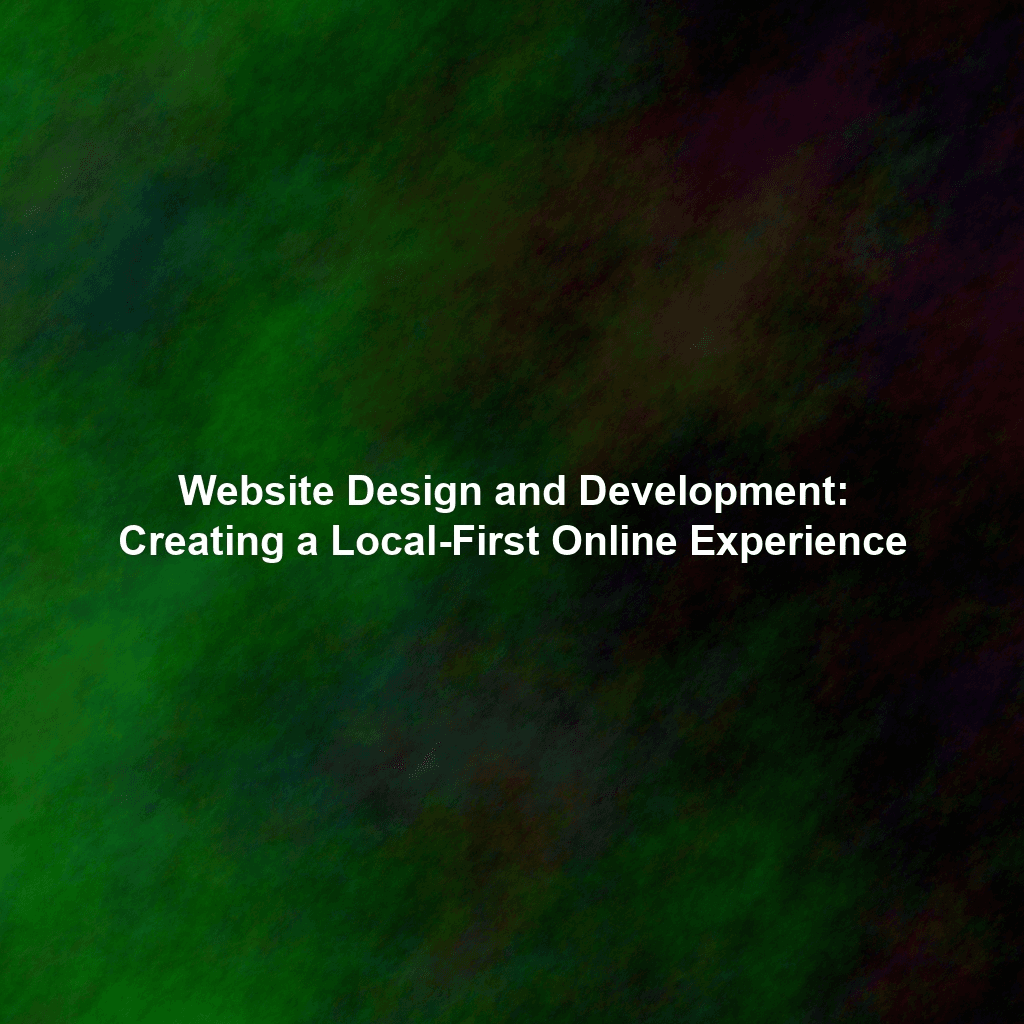Understanding the Power of Local in the Digital World
Why a Local-First Approach Matters
Consider the way people search online. Increasingly, users include location-specific keywords like “best pizza near me” or “plumbers in [your town]”. If your website isn’t optimized to capture these local searches, you’re missing out on valuable opportunities to connect with potential customers actively seeking your services. Furthermore, a local-first approach fosters trust and familiarity, demonstrating that you understand the unique needs and preferences of your community.
Crafting a Website That Speaks Locally
Creating a local-first online experience requires a strategic approach that integrates both design and development considerations. It’s not just about adding your address to the footer; it’s about building a website that resonates with local users from the moment they land on the page.
Design Elements for Local Appeal
Local Imagery and Branding
Visuals are powerful tools for conveying a sense of place. Incorporate high-quality images of local landmarks, community events, or even recognizable streets within your service area. This helps users immediately identify with your business and understand your connection to the community. Your branding should also reflect your local roots, whether through subtle color palettes or taglines that highlight your community commitment. Consider using images of your actual team, showing the faces behind the business can add a personal touch and build trust.
Localized Language and Content
Use language that resonates with your local audience. Avoid generic descriptions and instead, tailor your messaging to address the specific needs, interests, and challenges of your community. Highlight local initiatives you support, mention partnerships with other local businesses, and use local slang or idioms appropriately (being mindful of cultural sensitivity). Make sure your tone aligns with the character of your locality. Are you in a laid-back beach town or a bustling metropolis? Your website’s voice should reflect that.
User-Friendly Navigation for Local Needs
Ensure your website is easy to navigate, especially for local users who may be searching for specific information quickly. Create clear calls to action that are relevant to their immediate needs, such as “Get a Free Quote in [Your City]” or “Schedule Your Appointment Today.” Prominently display your contact information, including your phone number and physical address, making it easy for local customers to reach you. Also, consider adding a map to your contact page which clearly shows your location.
Development Strategies for Local Optimization
Schema Markup for Local SEO
Schema markup is a code that helps search engines understand the content of your website. By implementing local business schema, you can provide search engines with crucial information about your business, such as your name, address, phone number, business hours, and services. This improves your chances of appearing in local search results and helps customers find you more easily.
Mobile Optimization for On-the-Go Users
In today’s mobile-first world, it’s crucial to ensure your website is fully optimized for mobile devices. Local users are often searching for businesses while on the go, so your website must be responsive and provide a seamless experience on smartphones and tablets. Pay attention to page load speed, mobile-friendly navigation, and clear call-to-action buttons.
Location Pages for Targeted Content
If you serve multiple locations within your region, create dedicated location pages for each area. These pages should feature specific information about your services in each location, local testimonials, and relevant keywords. This helps you target local search queries more effectively and provides users with a more personalized experience. Also ensure these local pages are interlinked where relevant to improve the user experience and internal SEO.
Building Local Citations and Backlinks
Local citations are mentions of your business name, address, and phone number (NAP) on other websites. These citations help improve your local search ranking and increase your visibility in online directories. Focus on building citations on reputable local directories, industry-specific websites, and social media platforms. Earning backlinks (links from other websites to yours) is a crucial part of SEO. Focusing on earning backlinks from other local businesses, local news outlets, and community organizations strengthens your local SEO profile.
Leveraging Local SEO: Getting Found by Nearby Customers
Website design and development are just the foundation. To truly maximize your local reach, you need to implement a robust local SEO strategy.
Google My Business (GMB) Optimization
Your Google My Business listing is often the first point of contact for potential local customers. Claim and optimize your GMB listing by providing accurate information, adding high-quality photos, and actively responding to customer reviews. Encourage customers to leave reviews and use relevant keywords in your business description. Regularly update your GMB listing with new content, such as posts about upcoming events or special offers.
Keyword Research for Local Targeting
Conduct thorough keyword research to identify the terms your local customers are using to search for your services. Use a combination of broad keywords (e.g., “plumber”) and location-specific keywords (e.g., “plumber in Austin, TX”) to target a wider range of searches. Integrate these keywords naturally into your website content, page titles, meta descriptions, and image alt tags.
Online Reputation Management
Your online reputation plays a crucial role in attracting local customers. Monitor online reviews on platforms like Google, Yelp, and Facebook, and respond promptly to both positive and negative feedback. Address customer concerns professionally and demonstrate that you value their opinions. A positive online reputation builds trust and encourages potential customers to choose your business.
Testing and Iteration: Continuously Improving the Local Experience
Website design and development is an ongoing process. Regularly test your website to ensure it’s performing optimally for local users. Monitor your website analytics to track key metrics such as traffic, bounce rate, and conversion rate. Use this data to identify areas for improvement and make adjustments to your website design, content, and SEO strategy. A/B testing different elements, such as call-to-action buttons or headlines, can help you optimize your website for maximum impact. Also, ask for feedback from your local customers about their online experience and use that feedback to make improvements.
Conclusion: Investing in Your Local Online Presence
Creating a local-first online experience is an investment in the long-term success of your business. By prioritizing the needs of your local customers and implementing effective website design, development, and SEO strategies, you can attract more local traffic, build brand loyalty, and establish a strong presence within your community. Don’t underestimate the power of “marketing agencies near me” – make sure your website is ready to capture the attention of those local searches and turn them into valuable customers.
 Skip to content
Skip to content

